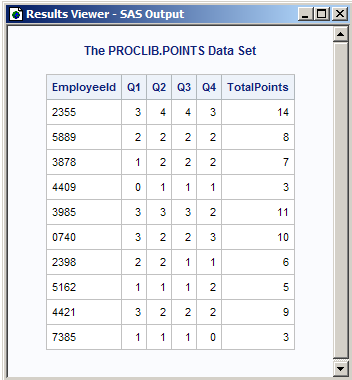FORMAT Procedure
- Syntax

- Overview
- Concepts
- Using

- Results
- Examples
 Create the Example Data SetCreating a Picture FormatCreating a Format for Character ValuesWriting a Format for Dates Using a Standard SAS FormatConverting Raw Character Data to Numeric ValuesCreating a Format from a Data SetPrinting the Description of Informats and Formats Retrieving a Permanent FormatWriting Ranges for Character StringsFilling a Picture FormatCreating a Format in a non-English LanguageCreating a Function to Use as a FormatCreating a Format for TrafficlightingUsing a Format to Create a Drill-down Table
Create the Example Data SetCreating a Picture FormatCreating a Format for Character ValuesWriting a Format for Dates Using a Standard SAS FormatConverting Raw Character Data to Numeric ValuesCreating a Format from a Data SetPrinting the Description of Informats and Formats Retrieving a Permanent FormatWriting Ranges for Character StringsFilling a Picture FormatCreating a Format in a non-English LanguageCreating a Function to Use as a FormatCreating a Format for TrafficlightingUsing a Format to Create a Drill-down Table
Example 5: Converting Raw Character Data to Numeric Values
| Features: |
INVALUE statement |
Program
libname proclib 'SAS-library-1'; libname library 'SAS-library-2';
proc format library=library;
invalue evaluation 'O'=4
'S'=3
'E'=2
'C'=1
'N'=0;
run;
data proclib.points; input EmployeeId $ (Q1-Q4) (evaluation.,+1); TotalPoints=sum(of q1-q4); datalines; 2355 S O O S 5889 2 2 2 2 3878 C E E E 4409 0 1 1 1 3985 3 3 3 2 0740 S E E S 2398 E E C C 5162 C C C E 4421 3 2 2 2 7385 C C C N ;
proc print data=proclib.points noobs;
title 'The PROCLIB.POINTS Data Set'; run;
Program Description
This program converts
quarterly employee evaluation grades, which are alphabetic, into numeric
values so that reports can be generated that sum the grades up as
points.
Create the numeric informat Evaluation. The INVALUE statement converts the specified values.
The letters O (Outstanding), S (Superior), E (Excellent), C (Commendable),
and N (None) correspond to the numbers 4, 3, 2, 1, and 0, respectively.
Create the PROCLIB.POINTS data set. The instream data, which immediately follows the
DATALINES statement, contains a unique identification number (EmployeeId)
and bonus evaluations for each employee for each quarter of the year
(Q1–Q4). Some of the bonus evaluation values that are listed
in the data lines are numbers; others are character values. Where
character values are listed in the data lines, the Evaluation. informat
converts the value O to 4, the value S to 3, and so on. The raw data
values 0 through 4 are read as themselves because they are not referenced
in the definition of the informat. Converting the letter values to
numbers makes it possible to calculate the total number of bonus points
for each employee for the year. TotalPoints is the total number of
bonus points.
